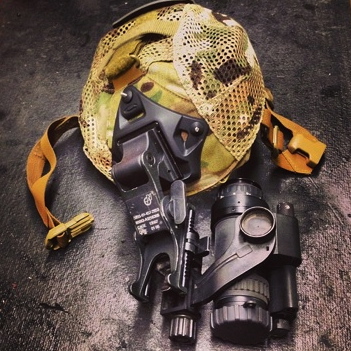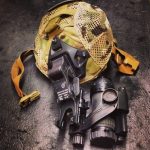Yesterday, I shared about the use of illumination flares and what to do when caught in one as well as began discussing the use of night vision in a patrol situation.
Night Vision Technology
Now, let’s talk a little bit about the night vision technology. Your standard night vision devices, such as the PVS-14, are image intensifiers. This means that they amplify ambient light to produce the familiar green image. (Now, you can get white image versions.) On a lighter night they work better, on a darker night not so good. This is because they magnify the available light. These are passive devices, in that they do not generate anything that can be picked up by an observer. They are equipped with an IR flashlight, which can be used to covertly illuminate a small area.
However, use of the IR flashlight device is an active measure that will be seen by anybody else using night vision equipment (just like an IR flashlight mounted on your rifle). Importantly, a night vision binocular or monocular is not a magical device. If you could hide from an observer with the naked eye, you can hide from an observer wearing a PVS-14. It is more a case that an observer with a PVS-14 has an advantage over one without. Yet both see worse than they would during the day, it is simply a matter of degree. Also, it is important to note that if you use an old-school binocular night vision goggle you will lose depth perception. This is why the monocular, such as the PVS-14, is preferable over the PVS-7. It allows you to retain night vision in the unused eye, and allows you depth perception.
Thermal Image Technology
A thermal imager, or FLIR, uses a different part of the IR spectrum than an image intensifier and detects heat emissions. Therefore, the picture you see is made up of the heat differentials observed. In that sense, a thermal imager is a little bit more magic than an image intensifier and shows you a video image. These devices are great for static observation. With a small handheld FLIR device about the same size as a PVS-14, you are looking at a tiny little video screen. In my opinion, such a device is best used for periodic scanning in a static OP or if out on patrol scanning from a static position over the ground ahead.
With both of these devices, the use of terrain, vegetation, and adverse weather conditions to mask your movement will be effective. Thermal imaging is a little bit harder to defeat.
Best Way To Mount And Use Devices
If you are mobile, rather than in a static OP position, there is a best way to mount and use these devices. In a static OP there is no reason why you cannot use an image intensifier or thermal imager just like a set of binoculars by having them around your neck and using them for routine scanning. You can also do this while on patrol. You can also have a thermal sight mounted on a rifle for static security work. If you have an image intensifier such as a PVS-14, then the best thing to do with it is mount it over your eye on something like a helmet or a purpose designed soft cap device like the Crye Nightcap, which is great for folding down and stowing unlike a helmet.
The head mount will allow the PVS-14 to be flipped up and out of the way as necessary. You don’t want your night vision device mounted as a sight on your rifle when on patrol, simply because you can only use it when aiming your rifle from the shoulder. If you want to patrol with the benefit of the PVS-14, then have this monocular device mounted over your eye so you can actually use it as you walk along.
Above: Crye Nightcap with PVS-14 Mounted
If you are also carrying a handheld FLIR thermal imager, then I recommend you keep this to hand in a pouch or hung around your neck. You can then stop, flip up the PVS-14, and scan with the same eye using the FLIR. If it matters to you, this will also preserve night vision in the unused eye.
Night Vision Options
There are a number of Night Vision Device options out there and new technology comes along all the time. The latest generation of devices includes ones with four “tubes”, giving you two tubes per eye. There are also combined thermal/IR devices available, which are amazing, but they come with an extreme price penalty. Combining thermal into an IR device seriously upgrades the capability of picking up and observing enemy out there. For a more reasonable price point you can pick up a PVS-14 from a reputable vendor, such as JRH Enterprises. It will cost you $3000 or more. That is a sickener, but given that it is literally a “night and day” difference I cannot put a price on it.
If you can afford it, or if you have to sell some safe queens from your collection, do it. At base, you should have a helmet mounted PVS-14 for patrolling and engaging and a thermal device for scanning. I would not even consider 1st or 2nd generation older items, particularly Russian equipment. I know there is an argument that something is better than nothing, and no doubt this statement will generate some comments. However, the 3rd Generation Autogated PVS-14 is such leaps and bounds ahead of even the PVS-7 that I would urge you to purchase.
Use With Rifle
Of course, having a monocular night vision device mounted over your eye, most likely your dominant eye, will give you difficulties if trying to engage enemy with your rifle. The solution to this is a weapon mounted IR laser, zeroed to your weapon. This bridges the gap between what you can see through your monocular and the fact that you cannot use your sights. These IR lasers will give you effective engagement distances out to maybe 100 or 200 meters, which is all you need. To engage, you simply turn on the laser with the switch mounted on your hand guard, point, picking up the laser dot through your PVS-14, and shoot.
So to be clear, do not mount your PVS-14 to your rifle or try to sight through your rifle using NV capable day sights along with your head mounted PVS-14. Use the IR laser by looking over your sights and pick it up through your head mounted PVS-14. Use the momentary switch so that your laser is not on all the time, giving you away to other night vision equipped people. The one time that I would consider using a weapon mounted night sight would be a thermal sight mounted on a designated marksman rifle. This would be used from a defensive OP, or from a support by fire position for offensive action. Note that a thermal-only device will not pick up an IR laser, including those of friendly troops. Also note that thermal will not see through glass, which informs where you will position your observer.
Discouraged For CQB
As to my comments about using head mounted night vision for CQB, I would urge you not to do it, but use judicious use of white light inside buildings. The PVS-14 only gives you a 30 degree field of vision, and it has to be focused to a certain distance. (We usually focus it out for patrolling.) This means that at close range you have limited blurry vision (albeit you can see what you can see out of your other eye and peripheral non-aided vision). Thus, imagine entering a dark room; someone can get on you at close range fast. Also, recall that absent ambient light, such as in a dark room, you need to use artificial IR light to see with a night vision device. Hence, there’s the clever use of white light for CQB.
Tomorrow, we’ll pick up with how to mount your night vision to your head and talk more about fratricide before concluding this article series.
About The Author
Max Alexander is a tactical trainer and author. He is a lifelong professional soldier with extensive military experience. He served with British Special Operations Forces, both enlisted and as a commissioned officer; a graduate of the Royal Military Academy Sandhurst. Max served on numerous operational deployments, and also served as a recruit instructor. Max spent five years serving as a paramilitary contractor in both Iraq and Afghanistan. This included working on contract for the U.S. Government in Iraq, a year of which was based out of Fallujah, and also two years working for the British Government in Helmand Province, Afghanistan. He operates Max Velocity Tactical (MVT).












Good article. It really takes some time out in the field to realize the importance of good night vision and how it could truly save you and your family’s lives one day.
Another outstanding article. My experience in the Army was with old generation AN/PVS-2, AN/TVS-4 (for M2 .50 cal), and tank-mounted passive and thermal. This field has changed so much, that much of my old knowledge is out of date. This article is a great update.
I wonder how many average people can afford these high tech units?
And if these items are critical for your survival than most preppers are doomed.
Im average and I have 2 sets. 1 PVS14 for my wife and and I have a AN/PSQ20. They are very critical as a force multiplier and well be very advantageous during a survival situation for defense as well as offense.
Yes, night vision is not cheap. 3k is reasonable with proper money management. What is your life or you families well being worth to you?
Max, a question for you…
I have an AR equipped with a Pulsar Digisight digital weapon scope which I use for hog hunting. The Digisight is relatively heavy (35oz), but otherwise suits my purposes well, and it functions in both daylight and darkness. My thoughts (in a defensive situation) would be to utilize this weapon in our OP for surveillence within a 300 yd range. Have you ever used a Digisight, and what are your thoughts on the capabilities of such a combination?
Can you expand on why you don’t recommend looking at your rifle sights through your helmet mounted pvs14? A night vision compatible red dot reflex sight for example? I get the advantages of the IR laser, but as you said, it makes you visible also…seems like a liability. I don’t know, are the red dot reflex sights also visible to an adversary with NV capability?